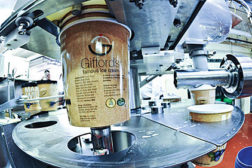Dairy Processor News
A cross-functional sustainability team asks “why not?” as it examines processes and procedures.
Read More
Gifford's famous ice cream is made in Maine
The Maine ice cream processor focuses on flavors, distribution, customer service and employee relations. Those factors add up to a successful and growing business.
May 15, 2012
Gifford's makes ice cream with family recipes, vintage equipment
Gifford’s makes the world’s best chocolate ice cream using old-fashioned recipes and equipment at its little plant in Skowhegan.
May 15, 2012
Dairy is in the diet of poor Americans
Those on food aid buy milk and yogurt, according to a new study by the USDA. Their food choices are not much different than any American’s.
May 14, 2012
Stay ahead of the curve. Unlock a dose of cutting-edge insights.
Receive our premium content directly to your inbox.
SIGN-UP TODAYCopyright ©2024. All Rights Reserved BNP Media.
Design, CMS, Hosting & Web Development :: ePublishing






